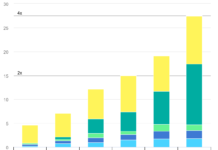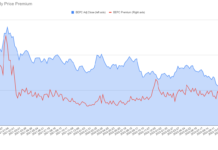by John V. Anderson
The Water-Electricity Connection: Basic Principles
There’s been a lot of discussion – and a fair amount of controversy – lately about water use in power plants. Unfortunately a lot of this discussion is based on an incomplete understanding of the fundamental issues involved. First of all, virtually all of the non-hydro power we consume is generated by heat engines of one sort or another. All heat engines absorb energy from a hot source (e.g. a flame, nuclear core, or solar), and they all reject energy to a cold sink – that is they all need some type of cooling.
And of course all heat engines are subject to the laws of thermodynamics which dictate that the maximum efficiency a heat engine can achieve is a quantity called the Carnot efficiency. The most important impact of this law for our purposes here is that the efficiency of any heat engine is strongly dependent on the difference in temperature between the hot temperature and the cold temperature. If we can raise the hot temperature relative to the cold temperature, or lower the cold temperature relative to the hot temperature, then we can improve efficiency. Since any energy not converted to electricity must be rejected, increasing the efficiency has the additional salutary effect of reducing the amount of energy that must be rejected.
Gas Turbines
Now, gas turbines (or combustion turbines) appear to violate this rule since they don’t need water cooling. However, this is deceptive. In fact, they are simply using the atmosphere as their cool reservoir. They pull cool ambient temperature air from the atmosphere and then return it to the atmosphere at a very high temperature (typically 1000 F or more). The maximum temperature inside a gas turbine is limited by materials issues, and is pretty well fixed for the purposes of our discussion. Since the hot temperature is essentially fixed, the temperature difference is driven by the temperature of the inlet air: the cooler the inlet air the higher the efficiency. (You might note that gas turbines are actually running at their poorest efficiency during the very hottest summer days when they are most commonly used for peak generation.)
Looking at the exhaust from a gas turbine, it is fairly obvious that this very hot air still has quite a bit of energy in it even though it is at too low a pressure to be useful in a turbine. Combined cycles work by using this high temperature exhaust air to boil water and raise steam for a steam turbine, usually referred to as a “bottoming cycle”. It is identical in nearly all respects to any other steam cycle except for the source of heat.
Steam Cycles & Types of Cooling
In a typical steam cycle (a version of a heat engine called a Rankine cycle) the highest temperature is the steam leaving the boiler to go to the turbine, and the low temperature is in the condenser where that steam is condensed before returning to the boiler. Raising the temperature from the boiler and/or lowering the condenser temperature will increase the efficiency. As before, the hot steam temperature is set by materials constraints and conditions within the system and is pretty well fixed (see below). The condenser temperature is dependent on ambient conditions and on the type of cooling used.
There are actually three approaches to cooling steam cycles. The first is to draw water from a lake, river or ocean, use it to cool the condenser of the plant, and then return it to its source. Unfortunately this requires pumping a large amount of water and the return water is typically much warmer than the inlet water, leading to undesirable ecological consequences. For these reasons this type of cooling is used much less frequently in the last couple of decades. However, this approach has the advantage that the difference between hot and cold temperatures – and thus the efficiency – is almost entirely independent of ambient temperature. The plant will run at the same efficiency winter or summer.
Recalculating Cooling
The second cooling approach is called “recirculating” cooling. In this approach, water is circulated between the condenser and a cooling tower. In the cooling tower some of the water is evaporated, and the rest is circulated back to the condenser. New water is added on each cycle to replace the water that is evaporated and to prevent the buildup of dissolved salts in the water. Now as we all know from swimming, evaporating water absorbs quite a lot of energy and can cool things pretty effectively (this is the difference between dry bulb and wet bulb temperatures). Thus the evaporation of some of the water will cool the remainder of water to well below ambient temperature. This is particularly true on very hot, dry days, which create peak loads and the highest demand for power. Using this type of cooling largely relieves the dependence of the efficiency on the ambient conditions.
Dry Cooling
The third type of cooling is dry cooling. The warm water from the condenser is run through a series of fan-coils (think of a really, really big automobile radiator). Ambient air is blown past the fan coil and the water is cooled to slightly warmer than the ambient air. Now, this approach has been used only rarely for large steam plants (although it is pretty common in some smaller geothermal plants) because it extracts several types of penalty on the cost of energy. First of all, as we have seen above the efficiency of the plant now decreases as the ambient temperature increases. This effect can amount to a 20% or more reduction in the instantaneous output of the plant, and perhaps a 5-10% decrease on an annual basis in hot locations like the Mojave or Sonoran deserts. In addition, the fan-coils used to cool the water are fairly expensive relative to a cooling tower.
Hybrid Cooling
A new hybrid approach to cooling is emerging which can reduce both the performance penalty of dry cooling and the amount of water consumed by recirculating cooling. This hybrid technique uses dry cooling whenever the ambient temperature and the power demand are low enough. Then as the temperature and the power demand rise, wet cooling is used to supplement the dry cooling and minimize the efficiency penalty on very hot days. Although this approach increases the cost of the system it is likely to see increased use, especially in the southwestern US where water issues are coming to the fore.
Cost and Water Savings
With this understanding, the issue of cooling becomes one of cost, and we can start to have a rational discussion about tradeoffs and how we value things. Electricity made in dry and/or hybrid cooling plants will cost somewhat more than in a recirculating cooling system, but will use less water. Is the additional water worth enough to justify the additional cost for water? Or is a lower power bill worth enough to justify additional water use for power generation?
Water Use in Solar Power
This issue of cooling and water use is currently raising lots of questions (and creating lots of confusion!) because of the concern about large solar thermal plants in the deserts of CA and AZ. Today’s reality is that some types of solar plants have material limitations that keep the hottest temperature lower than in a coal or nuclear plant. For this reason, their efficiency is slightly lower (perhaps 28-30% vs 32-34%) and thus their cooling needs are slightly higher. However, please note that the solar thermal technology is rapidly evolving, and there are already several approaches that are likely to eliminate this difference in the hot temperatures in the next generation of plants.
To some extent, solar thermal is a victim of timing. Earlier coal and nuclear plants routinely purchased water rights which almost no one took exception to. In this regard solar thermal plants are being held to a higher standard than the earlier conventional plants. However, that is the growing reality of life in the southwestern US, and we will all need to adapt to it.
As an aside, photovoltaic solar (PV) doesn’t require any cooling water. However, it has two other disadvantages relative to solar thermal. The first is cost. The societal cost (total installed cost, not the cost to the owner) of a PV system remains significantly higher than that for a solar thermal plant. Ongoing efforts by the PV industry to lower those costs seem likely to reduce that cost disadvantage, but the non-solar (balance of plant, or BOP) parts of a PV system will still likely cost between $3 and $4 per peak watt regardless of what the panels cost.
Timing of Solar Electricity
The second disadvantage is more serious from a broader system perspective. PV makes electricity instantaneously as sunlight hits it. If the system doesn’t need the energy at that time, more cost-effective systems must be turned down or the PV energy must be sloughed off. On the other hand, although the peak in PV output correlates fairly well with the beginning of the peak demand periods (usually mid-afternoon on hot summer days in this part of the world), the output from the PV system falls off too early to meet the tail of the peak load that extends into the evening (end of peak on the APS system is now 8:00 PM).
A further disadvantage is that all the PV systems in a particular geography are likely to turn on and off essentially together. If there are only a few PV systems on a particular power line this isn’t much of an issue. However, as the PV-generated power becomes a larger fraction of the energy on that line the sudden jump or drop from all the PV systems going on or off simultaneously creates significant difficulty for managing the loads on that line.
By contrast solar thermal plants can store the hot liquid they generate so that they can “ride through” short periods without sun, or shut down in an orderly manner for longer cloudy periods. In addition, if the storage is large enough the plant can simply collect energy from the sunlight without generating electricity until the grid needs the power. For example, the SEGS plants in CA routinely generate 100% of its capacity through all of Southern California Edison’s peak summer periods.
Conclusion
In many ways it is unfortunate that these questions don’t behave in a way that allows simple, quick answers. The electric grid is one of the largest and most complicated man-made devices ever assembled, and we are now operating it in ways that weren’t anticipated by its original designers. Despite that, it has provided low-cost and reliable energy that has powered our economy in so many ways that we aren’t even aware of many of them.
For a variety of excellent reasons we are now starting to re-think how we want this huge device to work and what new services we want from it. In order to make decisions that will work well for us over the long term we need to be smart about how this huge device actually works, what it can do and what it can’t. We all need to learn quickly and think carefully before we make changes.
John Anderson has a 30 year career in clean energy technology, investments and markets. He is currently an independent consultant helping clients with due diligence, project development, and strategic planning in the area of clean energy. His clients include electric utilities, Fortune 500 firms, and individual investors. Previously John served as the Manager of the Energy and Resources practice at the Rocky Mountain Institute, and the founding Managing Director of the Connecticut Clean Energy Fund, as well as the COO of a small fuel cell startup. John began his career at NREL, the National Renewable Energy Laboratory, where he worked on energy in buildings, concentrating solar power, geothermal, and solar chemistry technologies. John received a MSME from the Solar Energy Lab at UW-Wisconsin in Madison, and is a registered Professional Engineer.
John Can be reached at jva1000 [at] gmail,com or 303 885 9264









Thanks John–Great background on the issues of electricity and water use and the inexorable workings of the Laws of Thermodynamics.
Leslie Glustrom with Clean Energy Action
http://www.cleanenergyaction.org
I just wanted to comment on one form of cooling for thermal plants that I didn’t see mentioned… District heating. In cooler climates (Scandinavia), the excess heat is pumped out of the plant in the form of steam or hot water and then used to heat homes and buildings. The heat is sold, and so becomes an extra revenue source.
“In addition, if the storage is large enough the plant can simply collect energy from the sunlight without generating electricity until the grid needs the power. For example, the SEGS plants in CA routinely generate 100% of its capacity …”
To the best of my knowledge, SEGS doesn’t have thermal storage. What it does have is gas backup. (wikipedia/SEGS)
Bill-
The thermal mass of the working fluid in the pipes of parabolic trough based CSP plants such as the SEGS acts as short-term thermal storage, equal to 15-30min of production. I don’t think any of the SEGS had external storage, but this may be what John was referring to.